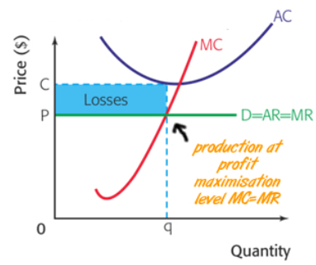Profit maximization is the central goal of most firms, requiring careful consideration of costs and revenues. Firms decide the optimal output level by comparing marginal revenue (MR) and marginal cost (MC). In the long run, all firms earn a normal profit.
Short-Run Profit Maximization
In the short run, firms maximize profit or minimize loss by producing the quantity where:
At this point, the revenue from selling one more unit equals the cost of producing it. Producing more would increase costs beyond srevenue, and producing less would forgo potential profit. This rule applies across all market structures but for perfectly competitive firms, since price (P) is constant and equals marginal revenue, the profit-maximizing rule becomes:

Firms must also consider whether to produce at all. If the price is below the average variable cost (AVC), they should shut down. Read more in 3.6 — Short-Run and Long-Run Decision-Making.
Graphical Analysis
- Profit is maximized where
- If , the firm earns an economic profit
- If , the firm incurs an economic loss but continues operating to reduce losses
Total Profit Calculation
Profit can be calculated graphically as the area between total revenue (TR) and total cost (TC) or mathematically as:
- If , the firm earns profit
- If , the firm breaks even
- If , the firm incurs a loss